Haryana State Board HBSE 6th Class Maths Solutions Chapter 10 Mensuration Ex 10.3 Textbook Exercise Questions and Answers.
Haryana Board 6th Class Maths Solutions Chapter 10 Mensuration Exercise 10.3
Question 1.
Find the area of the rectangles whose sides are :
(a) 3 cm and 4 cm
(b) 12 m and 21 m
(c) 2 km and 3 km
(d) 2 m and 70 cm.
Solution:
(a) Length of the rectangle (l) = 4 cm
Breadth of the rectangle (b) = 3 cm
.’. Area of the rectangle = l x b
= 4 cm x 3 cm
= 12 sq. cm.
![]()
(b) Length of the rectangle (l) = 21 m
Breadth of the rectangle (b) = 12 m
Area of the rectangle = l x b
= 21 m x 12 m
= 252 sq. m.
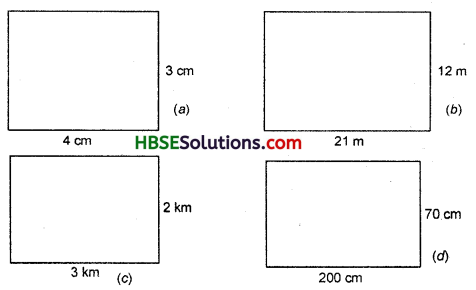
(c) Length of the rectangle (l) = 3 km
Breadth of the rectangle (b) = 2 km
∴ Area of the rectangle = l x b = 3km x 2km = 6 sq. km.
(d) Length of the rectangle (l)
= 2 m = 200 cm
Breadth of the rectangle (b) = 70 cm
∴ Area of the rectangle = l x b
= 200 x 70 sq. cm
= 14,000 sq. cm.
Question 2.
Find the areas of the squares whose sides are :
(a) 10 cm
(b) 14 cm
(c) 5 m.
Solution:
(a) Side of the square = 10 cm
∴ Area of the square = side x side
= 10 cm x 10 cm
= 100 sq. cm.
(b) Side of the square = 14 cm
∴ Area of the square = side x side
= 14 cm x 14 cm – 196 sq. cm.
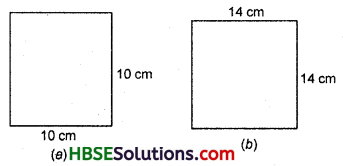
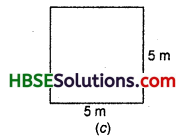
![]()
(c) Side of the square = 5 m
.’. Area of the square = side x side
= 5 m x 5 m
= 25 sq. m.
Question 3.
Three rectangles have the following dimensions :
(a) 9 m and 6 m
(b) 3 m and 17 m
(c) 4 m and 14 m.
Which one has the largest area and which one has the smallest ?
Solution:
(a) Length of the rectangle = 9 m
Breadth of the rectangle = 6 m
.’. Area of the rectangle = length x breadth
= 9 m x 6 m = 54 sq. m.
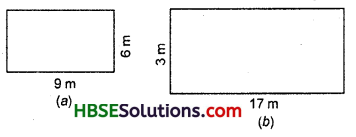
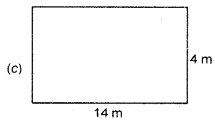
(b) Length of the rectangle (l) = 17 m
Breadth of the rectangle (b) = 3 m
∴ Area of the rectangle = l x b
= 17 m x 3 m = 51 sq. m.
(c) Length of the rectangle (l) = 14 m
Breadth of the rectangle (b) = 4 m
∴ Area of the rectangle = l x b
= 14 m x 4 m = 56 sq. m.
Rectangle (c) has the largest area and rectangle (b) has the smallest area.
Question 4.
The area of a rectangular garden 50 m long is 300 sq. m. Find the width of the garden.
Solution:
Area of the rectangle = 300 sq. m
Length of the rectangle = 50 m
Width of the rectangle = ?

∴ Area of the rectangle = length x width
∴ Width = \(\frac{\text { Area }}{\text { length }}=\frac{300}{50}\) = 6 cm
Hence, width of the rectangle = 6 m.
![]()
Question 5.
What is the cost of tiling a rect¬angular piece of land 500 m long and 200 m wide at the rate of Rs. 8 per hundred sq. m.
Solution:
Total area of the tiles must be equal to the area of the land.
Length of the land (l) = 500 m
Breadth of the land (b) = 200 m

∴ Area of the land = l x b
= 500 m x 200 m
Area of the tiles = 1,00,000 sq.m
Cost of 100 sq. m tiles = Rs. 8
Cost of 1 sq. m tiles = Rs. \(\frac{8}{100}\)
Cost of 1,00,000 sq. m tiles 8
= Rs. \(\frac{8}{100}\) x 1,00,000 = Rs. 8,000.
Question 6.
A table measures 2 m 25 cm by 1 m 50 cm. What is its area in square metres ?
Solution:
Length of the table (l) = 2.25 m
Breadth of the table (b) = 1.50 m
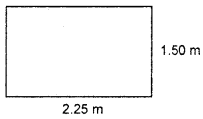
∴ Area of the table = lx b
= 2.25 x 1.50 sq. m
= 3.375 sq. m.
Question 7.
A room is 4 m 20 cm long and 3 m 65 cm wide. How many square metres of carpet is needed to cover the floor of the room ?
Solution:
Length of the room (l) = 4.20 m
Breadth of the room (b) = 3.65 m
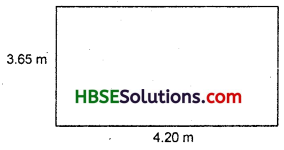
∴ Area of the room = l x b
= 4.20 x 3.65 sq. m
= 15.33 sq. m
Hence, area of the carpet needed to cover the floor of the room = 15.33 sq. m.
![]()
Question 8.
A floor is 5 m long and 4 m wide. A square carpet of sides 3 m is laid on the floor. Find the area of the floor that is not carpeted.
Solution:
Length of the floor (l) = 5 m
Breadth of the floor (b) = 4 m
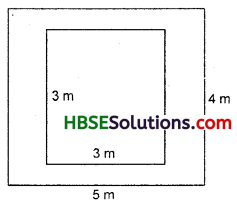
∴ Area of the floor = l x b
= 5 x 4 sq. m
= 20 sq. m
Side of the square carpet = 3 m
∴ Area of the square carpet = 3 m x 3 m
= 9 sq. m
Hence, area of the floor that is not carpeted = 20 – 9 = 11 sq. m.
Question 9.
Five square flower beds each of sides 1.2 m are dug on a piece of land 4.8 m long and 4.2 m wide. What is the area of the remaining part of land ?
Solution:
Length of the land (l) = 4.8 m
Bread of the land (b) = 4.2 m
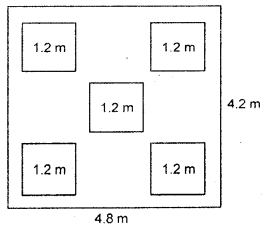
∴ Area of the land = l x b
= 4.8 m x 4.2 m
= 20.16 sq. m.
Side of one square flower bed = 1.2 m
∴ Area of one square flower bed
= 1.2 m x 1.2 m
= 1.44 sq. m
∴ Area of the square flower beds
= 5 x 1.44 sq. m
= 7.20 sq. m
Hence, area of the remaining part of the land
= 20.16 sq. m – 7.20 sq. m = 12.96 sq. m.
Question 10.
The following figures have been split into rectangles. Find their areas (The measures are given in centimetres).
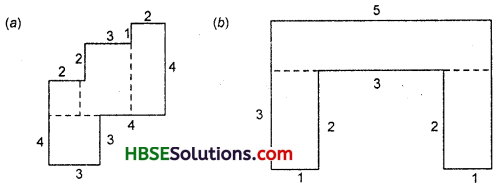
Solution:
(a) Total area of the given figure
= (3×3 + lx2 + 3×3 + 4×2)sq. m = (9 + 2 + 9 + 8) sq. cm
= 28 sq. cm
(b) Total area of the given figure
= (2 x 1 + 5 x 1 + 2 x 1) sq. cm
= (2 + 5 + 2) sq. cm = 9 sq. cm.
![]()
Question 11.
Split the following shapes into rectangles and find the area of each. (The measures are given in centimetres).

Solution:
(a) Total area of the given figure
= (10 x 2 + 10 x 2) sq. cm = (20 + 20) sq. cm = 40 sq. cm
(b) Total area of the given figure
= (7 x 7 + 21 x 7 + 7 x 7) Sq. cm = (49 + 147 + 49) sq. cm = 245 sq. cm.
(c) Total area of the given figure
= (4 x 1 + 5 x 1) sq. cm = (4 + 5) sq. cm = 9 sq. cm.
Question 12.
How many tiles with dimensions 5 cm and 12 cm will be needed to fit a region whose length and breadth are respectively :
(a) 100 cm and 144 cm
(b) 70 cm and 36 cm.
Solution:
(a) Length of the region (l) = 144 cm
Breadth of the region (b) = 100 cm
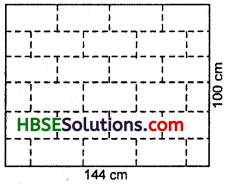
∴ Area of the region = 144 x 100
= 14400 sq. cm
Length of one tile = 12 cm
Breadth of one tile = 5 cm
∴ Area of one tile = 12 x 5
= 60 sq. cm
Number of tiles required = \(\frac{\text { Area of the region }}{\text { Area of one tile }}=\frac{14400}{60}\) = 240 tiles.
(b) Length of the region (l) = 70 cm
Breadth of the region (b) = 36 cm
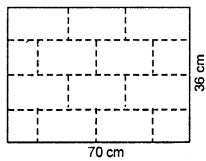
∴ Area of the region = 70 x 36 sq.cm
= 2520 sq.cm
Length of one tile = 12 cm
Breadth of one tile = 5 cm
∴ Area of one tile = 12 x 5 = 60 sq. cm
Number of tiles required = \(\) = 42 tiles